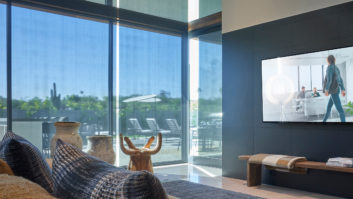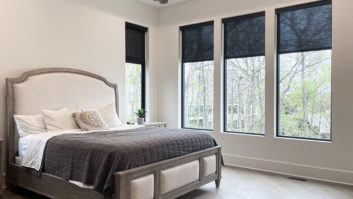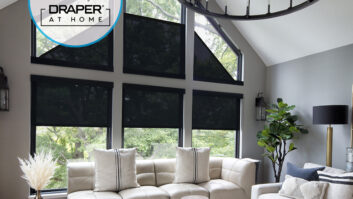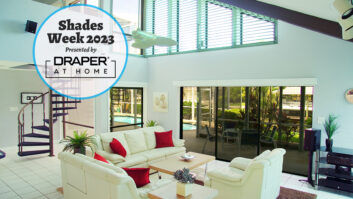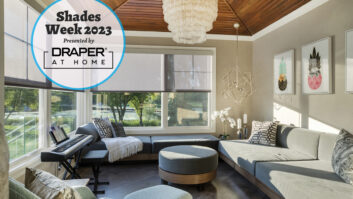In CEDIA’s Integrated Home Market Analysis, released in April, the survey’s respondents indicated that lighting and shading were among the categories experiencing the most growth. While it’s great news for installers looking to capture more revenue in the home technology sector that now exceeds $20 billion, for some it’s a category that can feel too outside the tech box. How can installers feel more confident adding it to their menu of offerings and being successful from the first installation? Residential Systems recently sat down with Shane Silloway, president of Shade Partners, and Charlie Derk, director of product marketing of Vantage and Legrand Shading Systems, to get their take on building a profitable shade business.
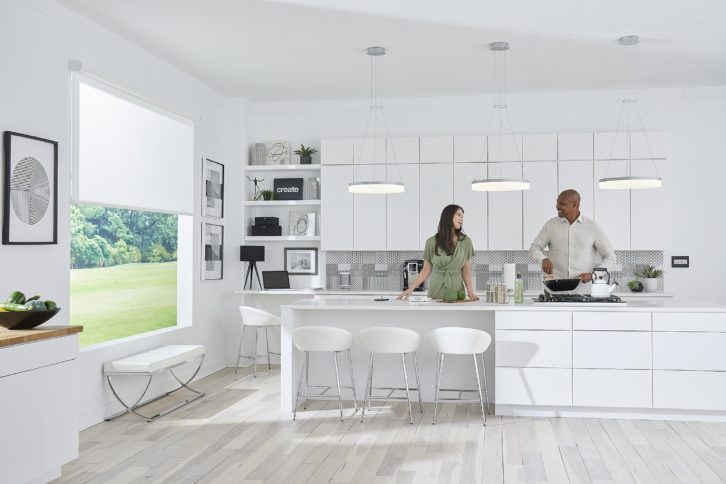
RESIDENTIAL SYSTEMS: Shane, tell us about your experience and Shade Partners.
SHANE SILLOWAY: I’ve been in shades or window coverings for about 32 years. My dad was also in the business. I also used to work for Legrand when QMotion was a startup and later acquired by Legrand. In 2018, I founded Perimeter 7, now Shade Partners.
And Charlie, you’re no rookie to shades either.
CHARLIE DERK: Like Shane, I’ve been in the industry for 24 years. I worked with two other manufacturers in the lighting and shading control industry, and as an integrator. I joined Legrand in 2018 to help with the shading business.
What kind of opportunities are there for installers in shading?
DERK: There are many opportunities, but it’s a new sales channel, so it’s vital to not be afraid of that. It costs money to acquire new customers when you start looking at advertising and the time it takes to build a social media presence. It’s easier to sell more to existing customers. In that regard, expanding your portfolio of products makes sense. When the lighting sales channel matured, everybody was afraid of lighting control, and it was considered something that only the electrician should do, but we can see how lighting control is a natural part of the home AV control experience. Now we’re in the same boat with shading.
Related: Finding the Right Shade Partner
What is key to successfully selling shades?
SILLOWAY: When I was transferred to Legrand’s San Francisco plant to take over as the regional sales manager for the Pacific Northwest territory, I was shocked to find out the sales were low; it was the worst market in the nation for sales. It didn’t add up because there’s a profitable high-end market in San Francisco. I thought maybe we needed more dealers, but after doing a couple job walks, I realized that wasn’t the problem at all. Lack of training was the problem, so we did a six-month training tour in different cities. It comes down to education and passing that information to the consumer. A key part of success is being able to educate them about fabrics and their performance, then go into the control system, what it can do, and how it integrates. You really have to be able to talk on both sides of the fence — shading as well as integration. You need to be the trusted advisor.
What is most challenging for integrators and how can they overcome that challenge?
SILLOWAY: The fabric books can be very intimidating to people that are scared of color. AV integrators don’t want to make a bad decision, but if you got yourself dressed this morning and look pretty good, you can absolutely feel confident enough to put a couple colors together. Start by picking a couple fabrics that you really like, one dark and one light. This will allow you to demonstrate visibility and glare and the benefits of light color fabric versus dark. The first 20 minutes of any project should be geared around fabrics, openness factor, and what that means. You only need to know a little bit about it to sound like the expert. I keep it simple and save more technical conversations for the architects.
DERK: Yes, keeping it simple is the best way to go. Ask the homeowner: What are you trying to accomplish? Are you trying to filter the sun and cut out glare? Are you trying to get privacy? Is it a bedroom and you want complete darkness? These three questions will help you understand what the homeowner wants to accomplish and will naturally lead you into the fabric discussion. From a fabric perspective, we see the majority of homeowners selecting neutral fabrics, so once you figure out what type of fabric, the color aspect is really straightforward.

Shane, can you explain your business model?
SILLOWAY: Shade Partners’ business model is a little bit different than the average dealer in the aspect that we don’t sell to the end-user. When I was with QMotion, I saw that some installers were great at selling shades while other weren’t. This is where my company comes in. We partner with AV integrators as well as builders, architects, interior designers, and lighting designers to do the shades for them. We provide a turnkey service that includes meeting with the homeowner to select fabrics, taking measurements, installation, and then helping the AV integrator integrate the product into the home automation system. We’ve made it very profitable for everyone.
DERK: I’m 100 percent onboard with Shane’s business model because I’ve seen that work in many places. When I was an integrator, some projects I took on myself while on others I brought in the experts. Dealers, like Shane, can be really successful just doing windows, even getting into specialty projects that go beyond strictly window shades but that complement the lighting experience. There’s plenty of profit to share.
What advice can you offer?
DERK: My words of encouragement would be just to embrace the new products. If you can make it work in your business, great. If not, partner with somebody like Shane to help so you can provide a better end-to-end customer experience. I’ve always told homeowners that you can’t control the lights on the ceiling unless you can control the light coming in the window.
When you’re working with architects and interior designers, how you go about speaking their language versus those who are in AV? How have you perfected that relationship over the years?
SILLOWAY: I’m really big on relationships, and AV integrators especially have a great opportunity to build a trusted circle with builders, electricians, and interior designers. Charlie brought up something very important about the high cost of acquiring a new customer. When you have a handful of builders, interior designers, and architects that you work with, they’re constantly feeding you business.
It’s really important to get out there and network with interior designers. Most interior designers are scared to death of AV and vice versa, but when they work together, it’s a wonderful marriage. Plus, interior designers have relationships all over, from the builder to the lighting designers they work with. They always need a good AV person. I’m working on a project right now where I know the architect, the lighting designer — who used to be my customer — and the builder. I’ve done projects with each of them. Now I’m forming a relationship with the interior designer on the project. This is the way of the future. It’s just a matter of time before everyone has some sort of smart home offering, whether it’s lighting control, motorized shading, audio — you name it. AV is becoming essential.
DERK: Everyone’s goal in life should be to make more money doing less work. When it comes to these relationships, your job is to make them look good by making their projects look good. If they can count on you to deliver something that works well and the customer isn’t complaining, they’re going to be happy and want to keep that relationship thriving. When I was an integrator, business was all through referrals. I even had a customer move to Florida. We didn’t do projects in Florida, but we took on the project, working with the architect and the builder. The builder said he’d never had a project go so smoothly before. After that, we were doing all of their projects. That symbiotic relationship is key.
SILLOWAY: Here’s another useful tip. I always thought that the interior designer was the first person in. It’s not. It’s the electrician. They know about projects that we don’t even know are coming out of the ground yet. That’s another person to include in your network.

What is the greatest pitfall to selling shades?
SILLOWAY: I see a lot of AV dealers doing $250,000 in AV and, because of that, they’ll throw in the shades for $50,000, when they should be $100,000. They’re losing out on immense profit.
DERK: One thing I see often with shades and lighting control is that an integrator goes through their pitch and explains all about the products, to which the customer responds, “Wow! This is great. I really want these motorized shades. I want lighting control for my house. How much does it cost?” Every dealer will say, “I need to count up loads, keypad locations, measure your windows, and then I’ll put a proposal together for you.” I guarantee you that after you leave and go start working on that proposal that the homeowner is meeting with the kitchen cabinet, pool, appliance, flooring, and other salespersons. All those people know how much their products cost. All of them help your client spend their budget that was earmarked for shading and lighting control. My number one recommendation is figure out on average what it costs to put a shade in a window. It doesn’t matter if it’s a small window or a large window, just get an average. That way when a customer asks, “How much does it cost?” you can respond immediately, “On average, it’s $2000 a window.” Right then, they’ll either commit and put that money aside versus spending it on other trades, or they’ll fall out of their chair. Now you’re not wasting your time running around the house measuring. Alternatively, they might say they can’t do the whole house. There’s still an opening there to steer the conversation. “Okay, how about the master bedroom and the living room?” Figure out what they’re willing to spend and focus on the important areas.
SILLOWAY: One of the main things I preach is that shades shouldn’t be given away. It’s a huge profit center. Once you have a customer, you need to prolong the sale as much as you possibly can by being the trusted advisor. When I come into a project through an AV integrator, I have to sell, sure, but it’s so much easier. I don’t get price-checked. We charge a premium for everything that we do. We’re high-end. We’re working on a $350,000 shade project right now for a $22 million home.
